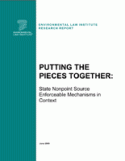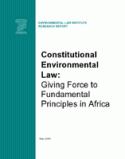
Research Reports
ELI publishes Research Reports available for free download that present the analysis and conclusions of the policy studies ELI undertakes to improve environmental law and policy. These reports contribute to education of the profession and disseminate diverse points of view and opinions to stimulate a robust and creative exchange of ideas. Those publications, which express opinions of the authors and not necessarily those of the Institute, its Board of Directors, or funding organizations, exemplify ELI’s commitment to dialogue with all sectors.This article, which originally appeared in the July 21, 2000, issue of Environment Reporter, examines the current "end-of-pipe" methods of reducing NOx emissions and suggests that a better method would be investing in new, combined cycle natural gas plants, cogeneration and efficiency gains. The second approach would not only reduce NOx emissions but other pollutants as well.
Read More >
Paying landowners not to pollute, providing free technical advice, and relying on voluntary adherence to BMPs has proven to be an incomplete strategy in many cases. Gradually, states are turning to enforceable mechanisms – including discharge prohibitions, direct enforcement of water quality standards, pollution abatement orders, required operating practices, nuisance and misdemeanor prosecutions, and civil and administrative penalties -- to supplement other approaches.
Read More >The Chesapeake Bay region has experienced significant growth during the past 30 years and continues to grow at a rapid rate. The population of the region increased 26 percent between 1970 and 1994 and is now expected to increase by an additional 3 million people by the year 2020. The resulting demand for new development, often low-density and single-use, has led to a significant loss of open land and the emergence of new pollution concerns.
Read More >This article, which originally appeared in the May 21, 2000, issue of Environment Reporter, examines data from the first four years of the Acid Rain Program as to the effects of trading on localized pollution levels. These indicate that the effects of trading have been minimal in regards to hot spots, and likely even positive. On a regional level, no significant trends can be discerned in the flow of trade allowances, and net interregional trades of allowances constitute only 3 percent of all allowances used.
Read More >
This research report explores how African constitutional provisions can be utilized to create real, enforceable environmental rights. African countries do have different legal traditions, namely, common law, civil law, and Islamic law, as well as some hybrid systems. Nevertheless, these legal systems share many common underlying principles and values, particularly fundamental human rights that are embodied in their respective constitutions.
Read More >